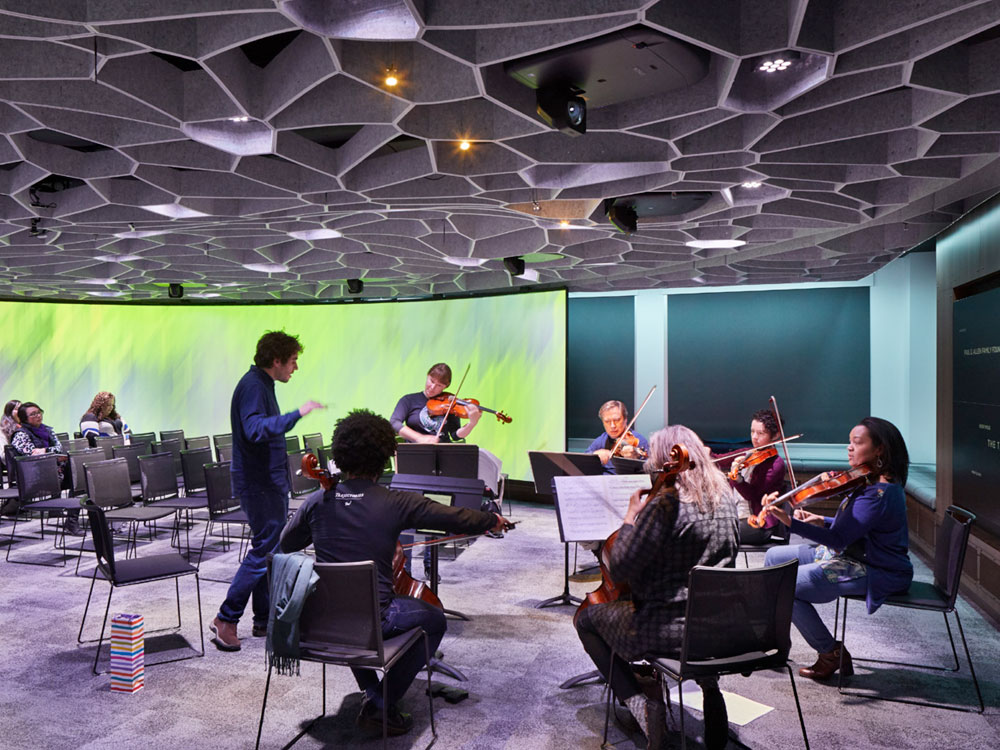
Core Design Team
Firm: LMN Architects
Design Team: Julie Adams, Associate AIA
Jenn Chen
Scott Crawford, Associate AIA
Thomas Gerard
Mette Greenshields, AIA
Cameron Irwin, Associate AIA
Erik Perka, Associate AIA
Mark Reddington, FAIA
George Shaw, FAIA
Consultants
Acoustic-AV: Jaffe Holden
Digital Acoustic Architecture: Meyer Sound
AV Integrator: Diversified
Electrical Design Build: Sequoyah Electric
Fire Protection: Columbia Fire
General Contractor: JTM Construction
Immersive Technology: Belle & Wissell, Co
Lighting Design: Schuler Shook
Mechanical Design Build: Holaday-Parks, Inc.
Structural Engineer: Magnusson Klemencic Associates
Project Narrative
Octave 9: Raisbeck Music Center creates a new immersive, experimental education and performance arts venue at Benaroya Hall, home of the Seattle Symphony. Incorporating sophisticated digital acoustics and projection technology, the renovation creates a highly flexible environment of “electronic architecture,” unbound by the dimensions of the room and allowing it to feel acoustically as reverberant as a concert hall, or as compact as the actual room. From this flexible platform, Octave 9 offers a hub for artistic and high-tech partnerships to explore new worlds of musical expression.
Octave 9 provides new access to music education and experimentation in downtown Seattle. The space expands on the Seattle Symphony’s well-established educational focus, while providing a venue to host performances, meetings, and community events. Octave 9 serves as an experimental space for artists and composers while providing a space in which one can explore the capabilities of the venue itself as an instrument for expanding interdisciplinary performance possibilities. It is transformable from a single area to accommodate larger groups, while providing 13 curving screens on circular tracks with numerous options for interactive projections, including a nearly-360-degree immersive experience.
To support the immersive experience, Octave 9 can transform acoustically and visually—allowing for an experience that can be customized to the programming. Using a sophisticated digital acoustic system, the room can be configured to produce musical experiences that cross genres, disciplines and realities. An array of microphones pick up the sound within the space, digital processors manipulate the signal in real time to recreate early reflections and reverberation, and then play the modified sound back through an array of loudspeakers in the ceiling and casework to imitate the acoustic performance of nearly any setting.
All surfaces and materials needed to be absorptive to limit the presence of acoustic reflections: floors are carpeted; casework is made of micro-perforated wood; resting instruments go into built-in storage spaces; a mobile bar for social events can be rolled out or put away. Speakers, microphones, projectors, lighting and HVAC are all integrated into a custom-designed acoustically absorptive ceiling. Composed of an array of sound absorbing cells made of a recycled plastic felt-like material, the ceiling design optimizes the room’s acoustic goals while also integrating technical, electrical and mechanical systems—including 10 projectors, 72 speakers, 28 microphones, and 68 color changing LED lights. The result is an intimate venue that is highly flexible and capable of morphing to the needs of the performance or activity, whether for a small school group, or an immersive, experimental performance.
The project represented a unique opportunity for the architect to also serve as the fabricator of the acoustic ceiling. Parametric modeling was used to generate the cellular geometry of the ceiling, allowing it to respond to the optimized layout of the other systems. This model also generated all of the necessary fabrication information for CNC cutting and identified the 687 cells, no two of which are the same.













